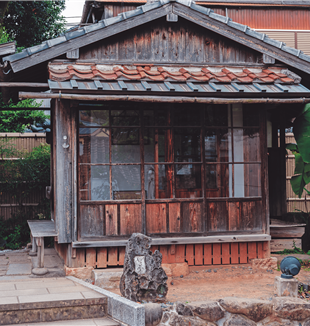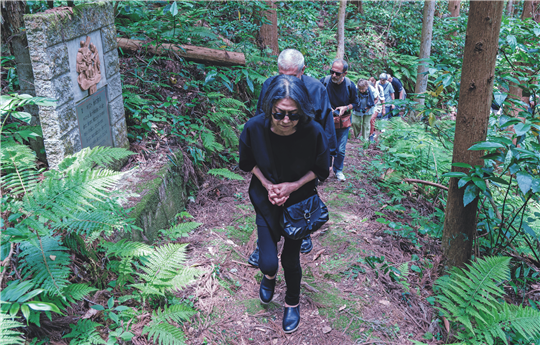
True joy, motionless, in a bed
On pilgrimage to the sites of Takashi Nagai, the Nagasaki doctor who lived entrusting himself to God. Even under the atomic bomb. From the September issue of Tracce .Participating in a 10-day pilgrimage to Japan organized by Russia Cristiana in the footsteps of Takashi Paolo Nagai gave us a close look at the places where his human adventure unfolded and was an opportunity to verify the depth of some of Giussani's statements in The Religious Sense.
Accompanied by Hitomi Yanagisawa, our Japanese guide, and Gabriele Di Comite, president of the Friends of Takashi and Midori Nagai Association, we went to discover Kyoto, the cradle of this country's culture, where we were immersed in some fascinating expressions of Japanese religiosity: the Buddhist temples and Shinto shrines rich in history and populated by the images of so many deities, the gardens embellished with streams and tree species that invite you to lose yourself in nature. All these aspects evoke the depth with which the Japanese people stand before a Mystery whose presence they sense, but to which they cannot put a face, and which therefore remains unfathomable. This deeply religious sentiment was nourished over time by the encounter between Shintoism and Buddhism, which over the course of two millennia has developed a form of syncretism defined by some as ‘atheistic religion,’ a perception of a ‘beyond’ that has no boundaries and in which the person is invited to identify themselves to the point of losing themselves.
Takashi Nagai grew up in this cultural context. A young medical student, he was nourished by the scientific materialism that was dominant in the Nagasaki university environment; in anatomy classes it was theorized that the person is nothing more than a concentrate of tissues and organs. Until the day when, before the gaze of his dying mother, Nagai’s view of life began to change. In the book Il rosario di Nagasaki [The Nagasaki Rosary], he writes: “The eyes of that woman who had given birth to me, educated me and loved me to the end, told me infallibly that her soul would remain with her dear Takashi even after death. I had a clear intuition that my mother's soul really existed.”
Nagai’s passionate reading of Pascal guided him to grasp the importance and, at the same time, the insufficiency of reason for the knowledge of truth, as he testifies in the same book, “For five years I was deeply troubled by a small voice that I heard both day and night: what is the meaning of our life? I read (...) but the more I read about philosophy, the more confused I became, but the more I was convinced that birth, life and death must have meaning.” During the course of his search, Nagai’s encounter with a Catholic family – the Moriyamas, who hosted him for a few years – and specifically with Midori, the woman who would accompany him to recognize the face of the Mystery, proved decisive.
The martyrs, a living fire. It was through Midori that Takashi Nagai got to know about the odyssey of the “hidden Christians” who, between the late 16th century and the mid-18th century, preserved their faith while living in total hiding because of the ban on professing their religion. Witnesses of Christ ‘usque ad sanguinem,’ as recounted by the Nagasaki Martyrs’ Monument we visited. It was there that the Jesuit Paul Miki and his 25 companions were crucified in 1597, after being led in chains for 600 kilometers on foot in the snow from Kyoto to Nagasaki, so that all might see the fate that would befall those who embraced the ‘foreign’ faith brought to those lands by Francis Xavier. In 2019, in front of the Martyrs’ Monument, Pope Francis paid homage to their faith and issued a warning, “May we never forget their heroic sacrifice! May it not remain as a glorious relic of the past, to be kept and honored in a museum, but rather as a living memory, an inspiration for the works of the apostolate and a spur to renewed evangelization in this land.”
Another place that is symbolic of the history of Christianity is the shrine of Mary at The Pass of the Virgin, which we reached by ascending along a forest above the town of Tsuwano, where a pilgrimage is held every year in which thousands of people participate. Hundreds of Christians were deported and martyred here from 1868 to 1873: 37 of them died as a result of torture. One of the survivors recounted the events he witnessed to Takashi Paolo Nagai, who described them in the book Il Passo della Vergine [The Pass of the Virgin], just published in Italian.
The scars of the atomic bomb. A visit to the Hiroshima Peace Memorial Museum, at the site where the first atomic bomb in history fell on August 6, 1945, causing 160,000 deaths, was a mournful journey that unfolded through the dramatic testimonies of that day: photographs and drawings that recount death and destruction, buildings emaciated in the atomic wasteland, the heart-breaking phrases of those who saw the shreds of skin peel away from their bodies, the tricycle on which a three-year-old boy was riding at the time of the explosion. In his office next to the cathedral, the Bishop of Hiroshima, Alexis Mitsuru Shirahama, commented, “The wounds of that day are still open in the hearts of the survivors and the families of the victims. But the most excruciating wound is seeing the spectre of nuclear war looming on the horizon, as if the lessons of history have taught nothing. The root of all this evil is in the heart of man, in his presumption to replace God, the root of all this evil: we ask God that our hearts may change.”
We then came to Urakami, now a neighborhood of Nagasaki, where the second atomic bomb fell on August 9, 1945, causing 70,000 immediate deaths and as many more by the end of the year from the aftermath of the blast. The church that was completely destroyed was rebuilt a short distance from the epicenter of the bomb and has been erected as the city's cathedral since 1962. An heirloom of faith and sorrow is preserved in a chapel: they call it the “bombed Madonna,” it is the head of a statue of the Virgin found in the rubble by a Japanese Trappist monk. Following the explosion, the eyes had melted away, leaving empty eye sockets and burn marks on the face. Next to it is a cross carved from a log to which Christians were tied and martyred.
Before Mass we heard the bells ringing, one of which was retrieved from among the ruins and rung on Christmas Eve 1945, amid the tears of the survivors. “Past and present meet mysteriously in this place,” commented Gabriele Di Comite: “Christianity took root 450 years ago in Urakami. This is where the 'hidden Christians,' deprived of the freedom to profess their faith, preserved the faith in hiding by handing down the treasure that sustained their lives in secret to their children. It is here that thousands were tortured and killed, it is here that the last act of World War II was consummated, making these people the sacrificial lamb to bring peace to the whole world.”
True freedom. Takashi Nagai lost his wife in the Nagasaki explosion. He only found her ashes and the rosary with which she prayed. The leukemia that had long since affected him led to his death within a few years. Those few years were spent in the Nyokodo, “the place of self-love,” a four-square-meter hut where our pilgrimage ended. The Nagasaki doctor prayed there, wrote books that have become best sellers, received thousands of people on pilgrimage to his bedside (even the emperor of Japan), spoke of the need for peace that starts with changing oneself, restored hope to women and men devastated by the atomic bomb, and exhorted us to look at pain while remembering that Providence is capable of drawing good from evil. “But above all,” Di Comite said, ”he fulfilled the last stretch of his journey of entrustment. He surrendered his existence to the Mystery whose face he had known, discovering that true freedom consists in dependence on the One who is the author of life. In the extreme poverty of the Nyokodo and the fragility of his health, Nagai understood in that he possesses everything by surrendering everything. He understood that he had found the truth of himself because his existence was now nourished only by friendship with God, by that which never dies.”
Read also - Takashi and Midori's "flowering hillside"
In Thoughts from Nyokodo, his last work, Nagai describes his total surrender in these words: “The first thing I think, every morning as soon as I wake up, is that I am happy. [...] It is an achievement of recent times that I surprise myself, every morning in my bed, full of this expectation of joy before the day begins. I find that I have the heart of a child. [...] We should turn our lives into poetry. We should let the poet's attentive and admiring gaze delve beneath the surface and glimpse the beauty hidden in everything and shape our every action and every thought. [...] I have finally reached this new horizon. A childlike heart pounds in my chest. The life of a new day awaits me, true joy in this two-meter bed from which I cannot even get out. But what is life without the whip of duties and the snares of prohibitions that arrest the boldness of this heart that gets to work again each morning.”